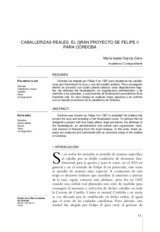Mostrar el registro sencillo del ítem
Caballerizas Reales. El gran proyecto de Felipe II para Córdoba
| dc.contributor.author | García Cano, María Isabel | |
| dc.date.accessioned | 2019-02-12T13:32:43Z | |
| dc.date.available | 2019-02-12T13:32:43Z | |
| dc.date.issued | 2017 | |
| dc.identifier.uri | http://hdl.handle.net/10396/17826 | |
| dc.description.abstract | Córdoba fue elegida por Felipe II en 1567 para establecer las caballe-rizas que fomentaran la raza y cría del caballo andaluz. Para conseguirlo diseñó un proyecto con cuatro pilares básicos: unas disposiciones lega-les; las dehesas del Guadalquivir; un organigrama administrativo y de atención a los animales, y unas fuentes de financiación procedentes de la hacienda real. En este trabajo se analizan estos aspectos y se culmina con un estudio económico de la caballeriza de Córdoba. | es_ES |
| dc.description.abstract | Cordova was chosen by Felipe II in 1567 to establish the stables that foment the race and breeding of the Andalusian horse. To achieve this he designed a project with four basic pillars: legal provisions; the dehesas of the Guadalquivir; an administrative and animal care organization chart, and sources of financing from the royal treasury. In this work, these as-pects are analyzed and culminated with an economic study of the stables of Córdoba. | es_ES |
| dc.format.mimetype | application/pdf | es_ES |
| dc.language.iso | spa | es_ES |
| dc.publisher | Real Academia de Córdoba de Ciencias, Bellas Letras y Nobles Artes | es_ES |
| dc.rights | https://creativecommons.org/licenses/by-nc-nd/4.0/ | es_ES |
| dc.source | Boletín de la Real Academia de Córdoba XCVI (166), 53-82 (2017) | es_ES |
| dc.subject | Dehesas | es_ES |
| dc.subject | Caballerizo mayor | es_ES |
| dc.subject | Caballos | es_ES |
| dc.subject | Raza | es_ES |
| dc.subject | Consignación | es_ES |
| dc.subject | Meadow | es_ES |
| dc.subject | Horse stable | es_ES |
| dc.subject | Horses | es_ES |
| dc.subject | Race | es_ES |
| dc.subject | Consignment | es_ES |
| dc.title | Caballerizas Reales. El gran proyecto de Felipe II para Córdoba | es_ES |
| dc.type | info:eu-repo/semantics/article | es_ES |
| dc.relation.publisherversion | http://hdl.handle.net/10853/189 | es_ES |
| dc.rights.accessRights | info:eu-repo/semantics/openAccess | es_ES |

